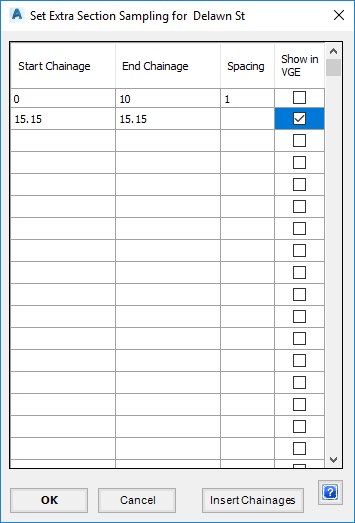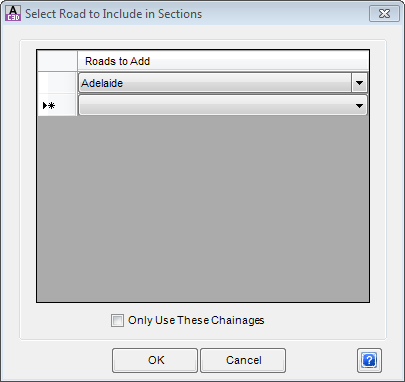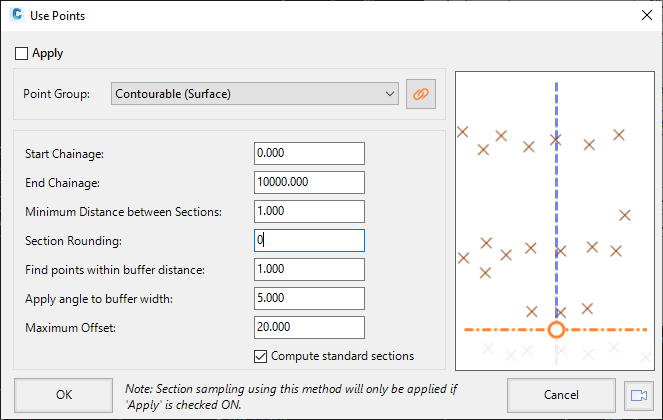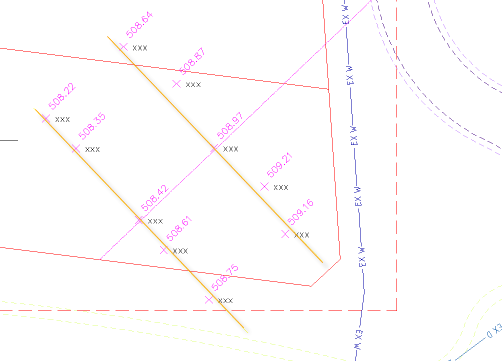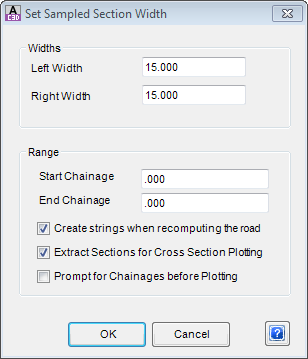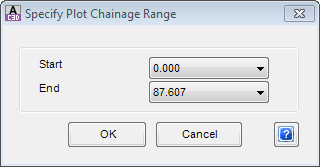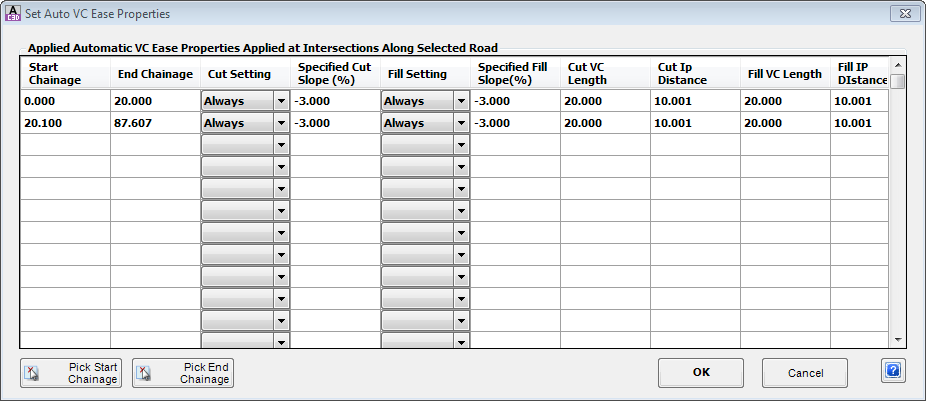Create/Edit Road
Icon: ![]()
![]()
![]()
Introduction
An integral part of the software is the process of creating Road Strings (aka Roads). A Road String is a special type of String object: as well as managing vertical and cross section geometry it also recognises other Road Strings where they intersect, with side road centrelines adjusting to match the cross section of main roads.
This command enables the creation of Road Strings which can then be designed vertically and managed with cross sections and interacts with other Road Strings where they intersect. If it is not desired for Road Strings to match levels where they intersect, a String (Profile) object should be created instead.
This command provides two distinct functions:
- Enables the creation of NEW Road Strings
- Opens the Vertical Grading Editor for existing CSD Objects (including Roads, kerb returns, cul-de-sacs, knuckles, roundabouts or other independent String/Profile) to be edited - selection can be made graphically or from a list.
Special Notes
It is vital that the following conditions are met for successful creation of a Road with this command:
- An existing surface must exist in the drawing AND extend for the full extent of all Road alignments and a sampling width for the proposed cross section, so that the software can assign 'existing' surface levels
- The alignment must be continuous (not consist of disconnected segments, which is supported in Civil 3D)
- The alignment must not have any commas in it, and some characters (such as @!#$%^&*) are not recommended
For Road Strings to identify intersections with other Road Strings, the following geometry considerations must be made:
- Alignments start/end at another continuous Road string alignment for a tee intersection. The intersection point must not meet the start/end of the 'main' road string alignment that it connects to, if automated intersections and kerb returns are expected.
- Alignments fully crossing another Road string alignment will be considered as crossing roads, requiring 4 kerb returns.
- Three or four alignments that start/stop at the same location will NOT be considered an intersection by the software
- Looping (self intersecting) alignments will not be considered as an intersection.
To optimise the Auto Road Creation command, the following is recommended:
- For Civil 3D customers, put r- in the description of the alignment. Alignments with r- in the description are set to be created as Road strings by default.
- For non-Civil 3D customers, alignments must be created with the Type set to 'Road'
For more information on the requirements please review the Design information.
Dynamic Display Window
The form featres a dynamic display window on the right hand side of the form. This updates the graphics as the user hovers over inputs, to indicate what aspect of the string creation/display is being managed by the input. Example of the dynamic view shown below:
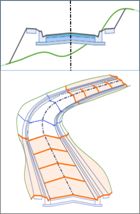
Details
Upon starting the command the software will:
- Scan the software for other Road Strings already created.
- Check for intersections. As part of the process for creating the string, the user will be prompted the user to select the side road where 'road' alignments cross - click here for more information regarding intersections at crossing alignments
- Allow the designer to select an alignment in the drawing (either by screen selection or from a form)
Upon selection of the alignment from the drawing or from a form, the software checks if it is an existing Road String:
- If a Road has not been created for the alignment, then the software will proceed through the Road String form, below.
- If a String (whether it be a Road, Kerb Return, Cul-de-sac, Knuckle, Roundabout
or other String) has been created from the alignment, then the software will open the
 Vertical Grading Editor for the designer to edit the vertical grading and/or the cross sections as required.
Vertical Grading Editor for the designer to edit the vertical grading and/or the cross sections as required.
Selecting an Alignment for an Existing Road
When the command is started the command prompt will request the user to 'Select alignment, or press Enter to select from a list'.
Designers can either pick an alignment from the drawing or press [enter] to obtain a list of available alignments:
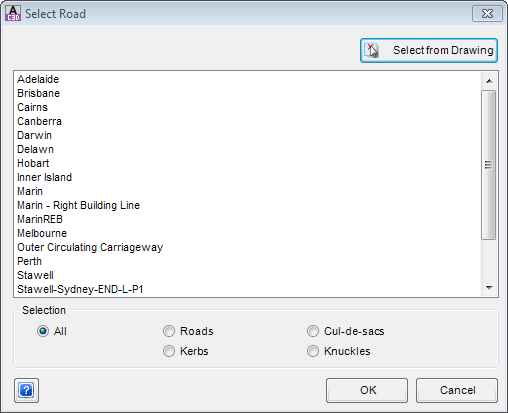
To select an alignment, pick one from the list and click OK. |
|
| List of Alignments | Displays all alignments in the drawing that may be used as Road, Cul-de-sac, Kerb or Knuckle Strings, as well as any other CSD Strings (roundabouts, general Strings, etc).
Use the left mouse button to select an alignment to either create as a Road or to open into the |
| Selection | This area allows the designer to filter the list for particular road objects |
| Selection Options: |
|
| Select from Drawing | Click on this button to enable graphical selection of an alignment in the drawing. |
| OK |
Proceed with either creating a new road or viewing the |
| Cancel | Exit the form without selecting an alignment |
Creating a NEW Road
If an alignment is selected that is NOT currently a Road in Civil Site Design then the designer will be guided through the process of creating a Road from the selected alignment.
Roads interact with each other, with Side Road profiles adjusting to match the cross section of the Main Roads at the intersections and the side road cross sections trimming to form up a total road network model.
The form enables the Designer to:
- Assign a typical cross section for the Road (through the assignment of a
 Template)
Template) - Assign the 'natural' surface levels for the Road
- Choose the sampling frequency along the Road
The details of the Create Road String form is as follows:
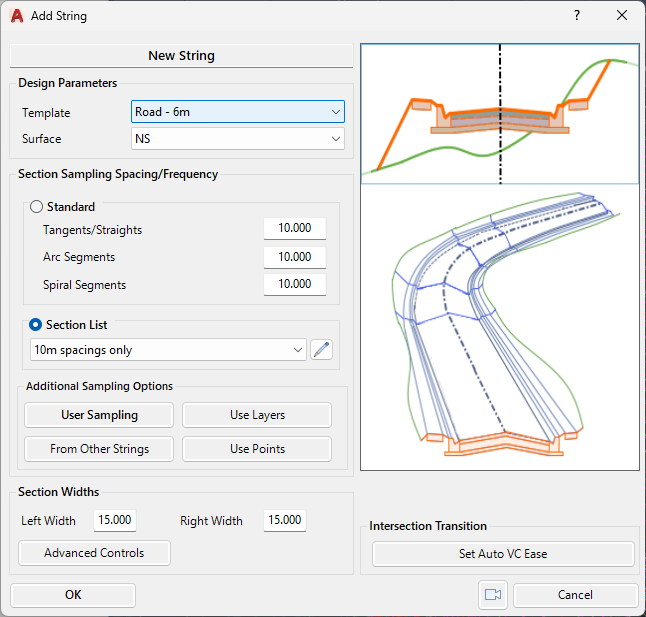 |
|||||||||||||||||||||||||||||||||||
| String Name | Non editable field confirming the alignment selected for String creation. | ||||||||||||||||||||||||||||||||||
| Design Parameters | |||||||||||||||||||||||||||||||||||
| String Type | Non editable field confirming the String type | ||||||||||||||||||||||||||||||||||
| Template | Use the pick list to select an appropriate Template to apply to the Roads. For more information on creating custom templates see the |
||||||||||||||||||||||||||||||||||
| Surface | Use the pick list to select the Surface to project any batters to as well as the comparison surface to see cut/fill depths for the design vertical grading. | ||||||||||||||||||||||||||||||||||
| Section Sampling Spacing/Frequency | |||||||||||||||||||||||||||||||||||
| Standard Radio button | Select this to enable standard sampling to be applied based on arc, spiral and tangent spacings. | ||||||||||||||||||||||||||||||||||
| Arc Segments |
Distance between sample sections along arc segments of the alignment centreline. |
||||||||||||||||||||||||||||||||||
| Spiral Segments | Distance between sample sections along spiral segments of the alignment centreline. | ||||||||||||||||||||||||||||||||||
| Tangents/Straights | Distance between sample sections along tangent segments of the alignment centreline. | ||||||||||||||||||||||||||||||||||
| Special Notes:
All geometry points, including the start/end points of the alignment, will automatically be sampled. |
|||||||||||||||||||||||||||||||||||
| Section List | Select this to enable a Section List to be applied to manage the horizontal geometry and standard spacings as per the Section List. With a Section list, users can set specific chainages to be excluded. | ||||||||||||||||||||||||||||||||||
| Section List picklist |
Pick a Section List for the
section spacings to apply. Special Notes: This option allows horizontal geometry (such as the start/end of curves on the alignment or horizontal IPs) to be removed Only the standard spacings and horizontal geometry controls are used from the named Section List that is selected here. |
||||||||||||||||||||||||||||||||||
| Edit Section List ` |
Click this icon to open the
Section Manager form to edit a section list |
||||||||||||||||||||||||||||||||||
| Additional Section Sampling Options | |||||||||||||||||||||||||||||||||||
| User Sampling | Opens a form to enable the establishment of user selected chainages and different chainage sampling frequencies:
|
||||||||||||||||||||||||||||||||||
| Use Layers | Opens a form to enable the establishment of additional section sampling based on the
START/END/VERTICES of Lines,
Arcs, Polylines & 3D Polylines on user selected layers in the drawing
within the search offset:
|
||||||||||||||||||||||||||||||||||
| From Other Strings | Opens a form to enable the adding of sampling from
other String/s. It is often desirable, when designing a string that is related to sections on another string, to sample the exact same sections.
|
||||||||||||||||||||||||||||||||||
| Use Points | Opens a form to enable the establishment of cross sections directly from COGO points in the drawing. Users establish filtering controls for searching for points to use. Point locations can be used for setting sampling chainages.
Cross Sections of the existing surface are built directly from the POINTS used - points are assumed to run along section lines at a 'common' chainage location for sampling of section elevations. Upon selecting the command the following form is displayed:
|
||||||||||||||||||||||||||||||||||
| Section Widths | This enables control of the sampling widths - the surface data is stored for this width for the purpose of matching batters and volume calculation. It also sets the default display width on the design cross section windows. | ||||||||||||||||||||||||||||||||||
| Left Width | Type a value (+ve) for the width of sections left of the centreline alignment | ||||||||||||||||||||||||||||||||||
| Right Width | Type a value (+ve) for the width of sections right of the centreline alignment | ||||||||||||||||||||||||||||||||||
| Advanced Settings | This enables the designer to adjust the default cross section widths (initially populated from the Selecting this option displays the following form:
|
||||||||||||||||||||||||||||||||||
| Intersection Transition | When a Road String intersections with another Road String to form a side road (eg: Tee intersection) the user is able to assign a default (and locked) IP to take the crossfall from the edge of the main road into the vertical grading of the side road, including a vertical curve. This traditionally is used to gently transition motorists from the road design grade of the side road to matching the crossfall of the main road. | ||||||||||||||||||||||||||||||||||
| Set Auto VC Ease | Opens a form to control how side road elevations match up and extend from the edge of a main road. These controls can
also be adjusted after creating a Road.
Form details are identical to the |
||||||||||||||||||||||||||||||||||
| Create/Update | Click to create a Road String from the alignment if not already created. Otherwise this will update (resample) the string. | ||||||||||||||||||||||||||||||||||
| Cancel | Click to cancel the command without creating a Road. | ||||||||||||||||||||||||||||||||||
Special Note: Users are not required to add extra sampling for the start/end, tangent/arc, arc/spiral, spiral/spiral or spiral/tangent geometry points along the alignment. The software automatically includes a sampled section at these points.
After the Road is created, yellow section lines can be displayed in the drawing to represent the sampling applied by Civil Site Design to each of the alignments. The dispaly of these lines is controlled from the Toggle Display command.
The ![]() Vertical Grading Editor will immediately open, with a default profile design provided and with the typical cross section applied.
Vertical Grading Editor will immediately open, with a default profile design provided and with the typical cross section applied.
Special Note: If any 'mistakes' were made at the time of creating the Road object, or if it is required to edit the sampled sections to update against a revised surface or reference a different surface users can run the ![]() Resample Road Cross Sections command.
Resample Road Cross Sections command.
